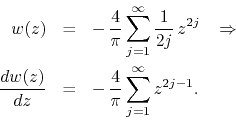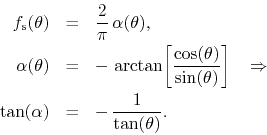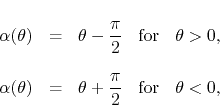Next: A Regular Cosine Series Up: Appendix: Examples of Limits Previous: A Regular Sine Series
Consider the Fourier series of the two-cycle unit-amplitude sawtooth wave. As is well known it is given by the sine series
![\begin{displaymath}
S_{\rm s}
=
-\,
\frac{4}{\pi}
\sum_{j=1}^{\infty}
\frac{1}{2j}\,
\sin[(2j)\theta].
\end{displaymath}](img317.png)
The corresponding FC series is then
![\begin{displaymath}
\bar{S}_{\rm s}
=
-\,
\frac{4}{\pi}
\sum_{j=1}^{\infty}
\frac{1}{2j}\,
\cos[(2j)\theta],
\end{displaymath}](img318.png)
the complex ![]() series is given by
series is given by

and the complex power series ![]() is given by
is given by

The ratio test tells us that the disk of convergence of ![]() is the
unit disk. If we consider the inner analytic function
is the
unit disk. If we consider the inner analytic function ![]() within this
disk we observe that
within this
disk we observe that ![]() , as expected. We have for the function and
its derivative
, as expected. We have for the function and
its derivative

This is a geometrical series and therefore we may write the derivative in closed form,

This function has two simple poles at the points where the two-cycle
sawtooth wave is discontinuous. These are hard singularities of degree
![]() . It is now very simple to integrate in order to obtain the inner
analytic function
. It is now very simple to integrate in order to obtain the inner
analytic function ![]() in closed form, remembering that we should have
in closed form, remembering that we should have
![]() ,
,
![\begin{eqnarray*}
w(z)
& = &
\frac{2}{\pi}\,
\left[
\ln(1+z)
+
\ln(1-z)
\right]
\\
& = &
\frac{2}{\pi}\,
\ln\!\left(1-z^{2}\right).
\end{eqnarray*}](img323.png)
This function has logarithmic singularities at the points where the two-cycle sawtooth wave is discontinuous. These are borderline hard singularities. If we now rationalize the argument of the logarithm in order to write it in the form
then the logarithm is given by
which allows us to identify the real and imaginary parts of ![]() . We may
write for the argument
. We may
write for the argument
![\begin{eqnarray*}
R\,{\rm e}^{\mbox{\boldmath$\imath$}\alpha}
& = &
1
-
\rh...
...ox{\boldmath$\imath$}
\left[
\rho^{2}
\sin(2\theta)
\right].
\end{eqnarray*}](img326.png)
From this it follows, after some algebra, that we have
![\begin{eqnarray*}
R(\rho,\theta)
& = &
\sqrt{1-2\rho^{2}\cos(2\theta)+\rho^{4...
...ft[\frac{\rho^{2}\sin(2\theta)}{1-\rho^{2}\cos(2\theta)}\right].
\end{eqnarray*}](img327.png)
The part which is of interest now is the imaginary one, which is related
to the series ![]() ,
,
![\begin{displaymath}
\Im[w(z)]
=
-\,
\frac{2}{\pi}\,
\arctan\!
\left[\frac{\rho^{2}\sin(2\theta)}{1-\rho^{2}\cos(2\theta)}\right].
\end{displaymath}](img328.png)
The ![]() limit of this quantity is the function
limit of this quantity is the function
![]() . If we consider the cases
. If we consider the cases ![]() and
and ![]() , we
immediately get zero, because the argument of the arc tangent is zero, and
therefore we get
, we
immediately get zero, because the argument of the arc tangent is zero, and
therefore we get ![]() . Therefore we have
. Therefore we have
![\begin{eqnarray*}
f_{\rm s}(0)
& = &
\lim_{\rho\to 1}
\Im[w(\rho,0)]
\\
&...
...i)
& = &
\lim_{\rho\to 1}
\Im[w(\rho,\pm\pi)]
\\
& = &
0.
\end{eqnarray*}](img302.png)
These are the correct values for the Fourier-series representation of the
two-cycle sawtooth wave at these points. For ![]() and
and
![]() we get
we get
![\begin{eqnarray*}
f_{\rm s}(\theta)
& = &
\lim_{\rho\to 1}
\Im[w(z)]
\\
&...
...}{\pi}
\arctan\!\left[\frac{\cos(\theta)}{\sin(\theta)}\right].
\end{eqnarray*}](img329.png)
In order to solve this equation we first write it as

Keeping in mind that we must have
![]() and
and
![]() , and paying careful attention to the signs of
the sine and cosine of either angle, one concludes that the solution is
given by
, and paying careful attention to the signs of
the sine and cosine of either angle, one concludes that the solution is
given by

which means that for
![]() we have
we have

These are the correct values for the two-cycle unit-amplitude sawtooth wave. The FC function is related to the real part
In the ![]() limit this function is singular at
limit this function is singular at ![]() and
and
![]() . Away from these logarithmic singularities we may write
. Away from these logarithmic singularities we may write
![\begin{eqnarray*}
\bar{f}_{\rm s}(\theta)
& = &
\lim_{\rho\to 1}
\Re[w(z)]
...
...\
& = &
\frac{1}{\pi}\,
\ln\!\left[4\sin^{2}(\theta)\right].
\end{eqnarray*}](img336.png)
We see therefore that the FC function to the two-cycle sawtooth wave is a function with logarithmic singularities at the two points where the original function is discontinuous. The derivative of this conjugate function is easily calculated, and turns out to be
This is a quite a simple function, with two simple poles at ![]() and
and
![]() . Note that the logarithmic singularities of the FC
function
. Note that the logarithmic singularities of the FC
function
![]() are integrable ones, as one would
expect since the Fourier coefficients are finite.
are integrable ones, as one would
expect since the Fourier coefficients are finite.
Note that we get a free set of integration formulas out of this effort.
Since the coefficients ![]() can be written as integrals involving
can be written as integrals involving
![]() , we have at once that for even
, we have at once that for even ![]()
for ![]() , while for odd
, while for odd ![]()
Note that
![]() is an even function of
is an even function of ![]() , so
that these integrals are not zero by parity arguments, and therefore we
also have
, so
that these integrals are not zero by parity arguments, and therefore we
also have
for ![]() .
.